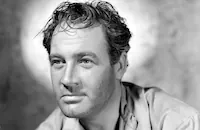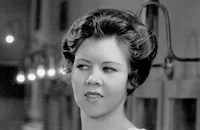Dulcy

Brief Synopsis
Cast & Crew
S. Sylvan Simon
Ann Sothern
Ian Hunter
Roland Young
Reginald Gardiner
Billie Burke
Film Details
Technical Specs

Synopsis
Though brimming with good intentions, the meddling Dulcy Ward causes a calamity whenever she puts her mind to something. One such disaster arises when Dulcy is meant to meet her brother Bill's fiancée, Angela Forbes, and her parents at the pier. Instead of greeting them, Dulcy is distracted by arriving ship passenger Gordon Daly and his adorable and newly adopted Chinese son, Kuh-too-Chu. Dulcy immediately falls in love with the child, whom she nicknames "Sneezy" because his Chinese name sounds like a sneeze, and insists on helping Gordon with the infant's feeding. Gordon, an inventor of a new airplane motor, is looking for a buyer, and when Dulcy accompanies him home, he demonstrates the Daly Internal Condenser for her. Interested in helping Gordon, Dulcy suggests that he take his invention to Roger Forbes, Angela's father. Certain that she will be able to manipulate Forbes into striking a business deal with Gordon through the use of psychology and careful planning, Dulcy invites Gordon to spend a weekend with the Forbeses and the Wards at a mountain resort. Upon their arrival at the resort, Dulcy stalls for time until she can put Forbes in the right frame of mind to be shown the motor. When Dulcy witnesses the crash landing of a plane on the lake, she rescues its pilot, who claims that he is millionaire Schuyler Van Dyke. Later, Forbes is given a demonstration of Gordon's motor, but because Dulcy accidentally removes the condenser during the unveiling, the device spurts oil in Forbes' face. Infuriated, Forbes insists that there is a "streak of insanity in the family," and decides to reconsider giving Angela his consent to marry Bill. Tormented by the accident-prone Dulcy and her disasters, Forbes decides to leave the resort. The next day, Bill convinces Angela to elope with him, and after they write a letter explaining their elopement, they give it to Dulcy to deliver to Forbes after they leave. The elopement is spoiled, however, when Forbes intercepts the letter before Bill and Angela leave. Desperate to regain the confidence of Gordon and her family, Dulcy explains her predicament to Van Dyke, who soon offers the inventor $10,000 plus royalties for his motor. After Van Dyke boasts that his acquisition of the motor will put Forbes out of business within a year, a man named Homer Patterson arrives and reveals that Van Dyke is really his brother Horace, who is an imposter suffering from delusions of grandeur. Forbes, however, does not believe Dulcy when she informs him of the ruse, and instead insists on making Gordon a better offer for his invention. As a result, Dulcy is redeemed in the eyes of her guests.

Director

S. Sylvan Simon
Cast

Ann Sothern

Ian Hunter

Roland Young

Reginald Gardiner

Billie Burke

Lynne Carver

Dan Dailey Jr.
Donald Huie

Jonathan Hale

Guinn "big Boy" Williams

Hans Conried
Robert Middlemass
Gerald Oliver-smith
George Lessey
David Oliver
Philip Van Zandt
Bert Moorhouse
Jerry Fletcher
Lester Dorr
Drew Demorest
Paul Parry
Eddie Dunn
Ivan Miller

Mary Treen

Joe Yule

May Mcavoy

Lee Phelps
Paul Power

Lloyd Ingraham
Jack Mulhall
Harold Miller
Ralph Byrd
Hal Le Seur
Crew
Adrian
Howard Campbell
Jerome Chodorov
Joseph A. Fields
Cedric Gibbons
Sydney Guilaroff
Frank E. Hull
Bronislau Kaper
Gilbert Kurland
Charles Lawton
Albert Mannheimer
Edgar Selwyn
Douglas Shearer
Edwin B. Willis

Film Details
Technical Specs

Articles
Dulcy (1940)
The film was adapted by Albert Mannheimer, Jerome Chodorov, and Joseph Fields from the 1922 George S. Kaufman-Marc Connelly play of the same name, which was based on a character created by Kaufman and Connelly's fellow Algonquin Round Table denizen, columnist Franklin P. Adams. The role was originated on stage by Lynn Fontanne, with the first film version in 1923 starring Constance Talmadge, and a remake with Marion Davies Not So Dumb in 1929.
Under director Sylvan Simon, production only lasted from June to July 1940 on the MGM lot and on location in the mountain resorts of Big Bear Lake and Lake Arrowhead, California, two hours from Los Angeles. There, Edi Jaun, the manager of the marina, rented an expensive Chris-Crafts boat to the producers. The stuntman hired to double Ann Sothern couldn't handle the boat properly and kept running into things. Jaun was afraid they would ruin the boat, and demanded that his nephew, Wilmer, take over. He was fitted with a blonde wig and did the scene without mishap. One of the onlookers was actress June Lockhart, who was living with her parents at Arrowhead.
Ann Sothern had made a career playing daffy dames, including the Maisie B-film series, which she would continue on radio and film throughout the 1940s. When the film was released in October 1940, New York Times film reviewer Bosley Crowther felt that she must have been getting bored playing the same character. "But apparently Metro-Goldwyn-Mayer isn't weary of having her do it, for here she is, cast again in another of those screw-loose comedies constructed along the lines of a rotating squirrel-cage. [...]Such crack-brained low comedy is only amusing when done with nimble zest. And this isn't. [...] Dulcy first showed back in 1921; she has not improved with the years and frequent imitation. In short--and to put it bluntly--the bloom is off the rose."
By Lorraine LoBianco
SOURCES:
Cozad, W. Lee More Magnificent Mountain Movies
Crowther, Bosley "THE SCREEN; Ann Sothern Plays a Daffy 'Dulcy' at Loew's Criterion" The New York Times 28 Nov 40
Erickson, Hal "Dulcy" Rovi
The Internet Movie Database
http://www.tcm.com/tcmdb/title/994/Dulcy/
Trailer Dulcy

Dulcy (1940)
Quotes
Trivia
The original play opened in New York on 13 August 1921, with Lynn Fontanne as the title character. The book Schuyler Van Dyke is reading, "Nuts! An Intimate Glimpse Into the Life of the American Peanut," originally was "Pschopathia-Sexualis," but was changed at the request of the Hays office.
Notes
A 1938 Hollywood Reporter news item indicates that Florence Rice was originally slated for the title role in this film, and in December 1939, Hollywood Reporter announced that Rosalind Russell was set for the title role. According to a Hollywood Reporter pre-release news item, background shots were filmed at Lake Arrowhead, California. The MPAA/PCA Collection at the AMPAS Library contains a letter sent by the PCA to M-G-M on June 6, 1940, in which the studio was warned to eliminate or alter several scenes and lines of dialogue: the "action of 'Dulcy' whispering in the waiter's ear suggests inescapably a 'toilet gag,'" Dulcy's line, "He forced it from my most intimate parts" and the title of the book "Pschopathia-Sexualis" were deemed unacceptable. Two weeks after the Hays office rejected the notion of the character Van Dyke carrying the book "Psychopathia-Sexualis," it approved the title "Nuts-The True Story of a Peanut," with the stipulation that the line "The True Story of a Peanut" be discernible to the audience. A Lux Radio Theatre presentation of Dulcy aired on March 29, 1937, and starred George Burns and Gracie Allen. Two previously produced films based on the same source are Dulcy, a 1923 First National release, directed by Sidney A. Franklin and starring Constance Talmadge and Claude Gillingwater; and Not So Dumb, a 1930 M-G-M release directed by King Vidor and starring Marion Davies and Elliott Nugent (see AFI Catalog of Feature Films, 1921-30; F2.1472 and F2.3893).















